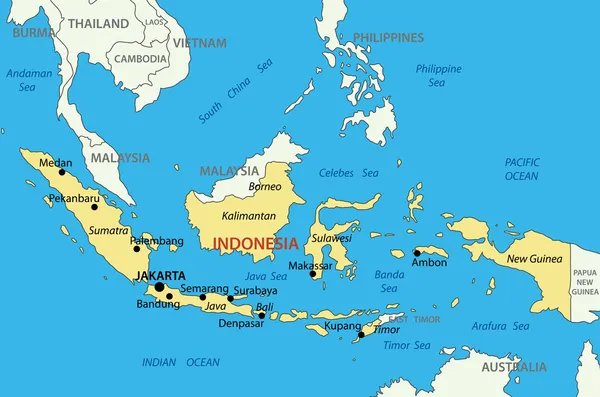Indonesia
Please watch this video to learn more about the general politics, history, and culture of Indonesia. You’ll quickly notice that Indonesia is a huge, very diverse and complex country, so you won’t be able to remember everything… but it gives you a great basis to understand Bali’s uniqueness in the country.


Bali
Click on the tabs below and read about the history of Bali!
Geological History
The island of Bali was formed about 15 million years ago by the subduction of the Indo-Australian plate under the Eurasian plate, forming a volcanic arc, including Bali’s three major volcanoes: Mount Agung, Mount Batur, and Mount Rinjani. Volcanic activity has been intense throughout Bali’s history, and most of the surface of the island has been covered by volcanic magma, creating very fertile volcanic soil and supporting the agricultural economy. Tectonic activity has also shaped the Coral Triangle with its many unique reefs, the rice terraces of the central mountains, and the white sand beaches of the south coast. As you will learn, volcanoes are also a central symbol and theme culturally.
Early History
The history of Bali can be traced back to the 7th century, when the island was first inhabited by a people known as the Bali Aga. The Bali Aga are thought to have migrated from other parts of Southeast Asia, and Oceania. Artifacts of this era were discovered in the region of Cekik, located at the western most tip of the island.
The Majapahit Empire
In the 14th century, Bali came under the influence and rule of the Majapahit Empire of Java. The Majapahit Empire was a powerful Hindu empire that ruled much of Southeast Asia at the time. The Majapahit rulers brought their culture and religion to Bali, and the island’s culture and religion were heavily influenced by Javanese Hinduism, Hinduism being the oldest religion in Indonesia.
The Independent Kingdom of Bali
The Majapahit Empire collapsed in the 15th century, and Bali became an independent Hindu kingdom. The kingdom of Bali was ruled by a series of powerful kings, and the island enjoyed a period of peace and prosperity.
The Portuguese Invasion
In the 16th century, the Portuguese briefly invaded Bali. The Portuguese were seeking to establish a commercial empire in Southeast Asia, and they hoped to control the spice trade in the region. However, the Portuguese were eventually driven out of Bali by the Balinese.
The Dutch East Indies
In the 19th century, Bali as well as the rest of the territories that now consist of Indonesia were then colonized and controlled by the Dutch East Indies — the trading company of the Netherlands— occupying it for 350 years. The Dutch ruled Bali indirectly, allowing the island to maintain a large degree of autonomy. However, the country’s resources and Balinese people themselves were deeply exploited. The Dutch empire grew rich from the spice trade, which sold cheaply bought spices at high prices in Europe. While this started as trade, the Dutch quickly began to steal the goods and relied on forced labor through indentured servants and slavery (Kerja-Paksa). Balinese society was oppressed and discriminated against, especially in terms of access to education. Despite this period of Dutch rule and conflict, Bali’s culture and traditions held strong against their oppressors.
WWII – Japanese Imperialism
In 1942, Japan invaded and quickly conquered the entire colony. The Japanese occupation of Indonesia lasted for three years, and it was a time of great suffering for the Indonesian people, resulting in an estimated 4 million Indonesians killed during the occupation, and many more injured or displaced. It was particularly brutal in Bali: the Japanese military forced the Balinese to work on forced labor projects, and imposed harsh restrictions on their movement and activities. During the occupation, many temples, cultural artifacts, and business were destroyed.
The Indonesian Revolution
In 1945, Japan surrendered the territory to the Allied powers of WWII and Indonesia declared independence from its former Dutch colonizers.
Sukarno was the first president of Indonesia, and was a charismatic leader who played a major role in the Indonesian independence movement as a vocal advocate. He was a popular leader, and he was able to unite the diverse Indonesian people under a common national identity. Bali became part of the new Indonesian republic, but it retained a large degree of autonomy from the muslim majority country.
Over the next few decades, Bali started to become a popular tourist destination, and the island’s economy grew rapidly. A devastating and deadly eruption of Mount Agung in 1963 and smaller ones in the last two decades have disrupted economic growth and led to internal migrations.
Additionally, Sukarno’s presidency was marked by instability and conflict, as well as a strong regime. In 1965, the Indonesian Communist Party was accused of trying to overthrow the government. Across the country, a violent purge of communists and their suspected sympathizers followed, killing an estimated 500,000 to +1-3 million people. Sukarno was blamed for the coup attempt, and he was forced to resign as president in 1967 and was imprisoned and died accused of being a Communist. Due to this, his legacy continues to be debated and highly controversial today.
The New Order (1966-1998)
In 1966, General Suharto seized power in a military coup. He established the New Order authoritarian regime, which ruled Indonesia for the next 32 years and was characterized by corruption, human rights abuses (suppressing dissent, silencing, disappearances), and increased economic inequality. In 1997, the Asian financial crisis led to Indonesia’s economy collapsing and the dictatorship and its political system being destabilized. Suharto resigned the next year due to mass student protests.
The Reformasi (1998-Present)
Suharto’s resignation ushered in a period of political and economic reform in Indonesia. Various presidents such as Habibi, Gus-Der, Sukarno Putih and others took the helm and made cases for reform (self-sufficiency, religious tolerance, anti-discrimination), with varied levels of success. The Reformasi has led to greater democracy and human rights in Indonesia, but it has also been marked by political instability and economic challenges.
Today, Bali is one of the most popular tourist destinations in the world. The island is known for its beautiful beaches, lush rice paddies, and rich cultural heritage. Indeed, Bali’s economy is primarily driven by tourism, though in recent years, the Balinese government has been taking steps to diversify the economy beyond tourism by promoting other sectors such as agriculture, manufacturing, and creative industries.
Current president elect of Indonesia, Joko Widodo (nicknamed Jokowi), came to the presidency in 2014 on a progressive platform and was the first president from outside of the Javanese elite.
Finally, feel free to watch this video for a few highlighted facts about Bali and check out Wikipedia for additional information (especially on recent major political events).
